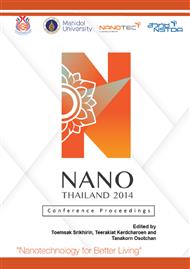[1]
J. Ouyang, Secondary doping methods to significantly enhance the conductivity of PEDOT: PSS for its application as transparent electrode of optoelectronic devices, Displays. 34 (2013) 423–436.
DOI: 10.1016/j.displa.2013.08.007
Google Scholar
[2]
J. Kawahara, P.A. Ersman, I. Engquist, M. Berggren, Improving the color switch contrast in PEDOT: PSS-based electrochromic displays, Org. Electron. 13 (2012) 469–474.
DOI: 10.1016/j.orgel.2011.12.007
Google Scholar
[3]
A. Bozkurt, A. Lal, Low-cost flexible printed circuit technology based microelectrode array for extracellular stimulation of the invertebrate locomotory system, Sensor Actuat A-Phys. 169 (2011) 89– 97.
DOI: 10.1016/j.sna.2011.05.015
Google Scholar
[4]
A.C. Hebler, G.C. Schmidt, H. Kemp, K. Reuter, M. Hambsch, M. Bellman, Three-dimensional integrated circuit using printed electronics, Org. Electron. 12 (2011) 419–423.
DOI: 10.1016/j.orgel.2010.12.010
Google Scholar
[5]
F.L.M. Sam, M.A. Razali, K.D.G. I. Jayawardena, C.A. Mills, L.J. Rozanski, M.J. Beliatis, S. R.P. Silva, Silver grid transparent conducting electrodes for organic light emitting diodes, Org. Electron. 15 (2014) 3492–3500.
DOI: 10.1016/j.orgel.2014.09.036
Google Scholar
[6]
S. Ouyang, Y. Xie, D. Zhu, X. Xu, D. Wang, T. Tan, H.H. Fong, Photolithographic patterning of PEDOT: PSS with a silver interlayer and its application in organic light emitting diodes, Org. Electron. 15 (2014) 1822–1827.
DOI: 10.1016/j.orgel.2014.05.004
Google Scholar
[7]
E. Nasybulin, S. Wei, I. Kymissis, K. Levon, Effect of solubilizing agent on properties of poly(3, 4-ethylenedioxythiophene) (PEDOT) electrodeposited from aqueous solution, Electrochim. Acta. 78 (2012) 638– 643.
DOI: 10.1016/j.electacta.2012.06.083
Google Scholar
[8]
S.H. Eoma, S. Senthilarasu, P. Uthirakumar , S. C. Yoon, J. Lim, C. Lee, H. S. Lim, J. Lee, S.H. Lee, Polymer solar cells based on inkjet-printed PEDOT: PSS layer, Org. Electron. 10 (2009) 536–542.
DOI: 10.1016/j.orgel.2009.01.015
Google Scholar
[9]
T. Yamashita, S. Takamatsu, K. Miyake, T. Itoh, Fabrication and evaluation of a conductive polymer coated elastomer contact structure for woven electronic textile, Sensor Actuat A-Phys. 195 (2013) 213– 218.
DOI: 10.1016/j.sna.2012.09.002
Google Scholar
[10]
D.M. Heinze J, G. Hey wang, F. Jonas, Electrochemical and spectroscopic characterization of polyalkylenedioxythiophenes, J. Electroanal. Chem. 369 (1994) 87.
Google Scholar
[11]
Q. Pei, G. Zuccarello, M. Ahskog, O. Inganas, Electrochromic and highly stable poly(3, 4-ethylenedioxythiophene) switches between opaque blue-black and transparent sky blue, Polymer. 35 (1994) 1347-1351.
DOI: 10.1016/0032-3861(94)90332-8
Google Scholar
[12]
R. Kiebooms, A. Aleshin, K. Hutchson, F. Wudl, Thermal and Electromagnetic Behavior of Doped Poly(3, 4-ethylenedioxythiophene) Films, J. phy. Chem. B. 101 (1997) 11037-11039.
DOI: 10.1021/jp9720101
Google Scholar
[13]
F.A.R. Silva, M.J.A. Sales, R.S. Angelica, E.R. Maia, A.M. Ceschin, Characterization of the PEDOT: PSS/KDP mixture on a flexible substrates and theuse in pressure sensing devices, Appl. Surf. Sci. 257 (2011) 8594– 8599.
DOI: 10.1016/j.apsusc.2011.05.023
Google Scholar
[14]
A. Lenz, H. Kariis, A. Pohl, P. Persson, L. Ojamae, The electronic structure and reflectivity of PEDOT: PSS from density functional theory, Chem. Phys. 384 (2011) 44–51.
DOI: 10.1016/j.chemphys.2011.05.003
Google Scholar
[15]
A. Dkhissi, D. Beljonne, R. Lazzaroni, Atomic scale modeling of interfacial structure of PEDOT/PSS, Synth. Met. 159 (2009) 546–549.
DOI: 10.1016/j.synthmet.2008.11.022
Google Scholar
[16]
S. Kirchmeyer and K. Reuter, Scientific importance, properties and growing applications of poly(3, 4-ethylenedioxythiophene), J. Mater. Chem. 2005, 15, 2077–(2088).
DOI: 10.1039/b417803n
Google Scholar
[17]
Y. Seekaew, S. Lokavee, D. Phokharatkul, A. Wisitsoraat, T. Kerdcharoen, C. Wongchoosuk, Low-Cost and Flexible Printed Graphene–PEDOT: PSS Gas Sensor for Ammonia Detection, Org. Electron. 15 (2014) 2971–2981.
DOI: 10.1016/j.orgel.2014.08.044
Google Scholar
[18]
M.J.S. Dewar, E.G. Zoebish, E.F. Healy, J.J.P. Stewart, Development and use of quantum mechanical molecular models. 76. AM1: a new general purpose quantum mechanical molecular model, J. Am. Chem. Soc. 107 (1985) 3902-3909.
DOI: 10.1021/ja00299a024
Google Scholar
[19]
C.C.J. Roothan, New Developments in Molecular Orbital Theory, Rev. Mod. Phys. 23 (1951) 69-89.
Google Scholar
[20]
Y. Kumeda, Y. Fukuhiro, T. Taketsugu, T. Hiramo, Theoretical study of nanotube growth in terms of frontier density distribution, Chem. Phys. Lett. 333 (2001) 29-35.
DOI: 10.1016/s0009-2614(00)01322-1
Google Scholar
[21]
M.W. Schmidt, K.K. Baldridge, J.A. Boatz, S.T. Elbert, M.S. Gordon, J.H. Jensen, S. Koseki, N. Matsunaga, K.A. Nguyen, S.J. Su, T.L. Windus, M. Dupuis, J.A. Montgomery, J. Comput. Chem. 14 (1993) 1347-1363.
DOI: 10.1002/jcc.540141112
Google Scholar
[22]
C. Aleman, E. Armelin, J.I. Iribarren, F. Liesa, M. Laso, J. Casanovas, Structural and electronic properties of 3, 4-ethylenedioxythiophene, 3, 4-ethylenedisulfanylfurane and thiophene oligomers: A theoretical investigation, Synth. Met. 149 (2005).
DOI: 10.1016/j.synthmet.2004.12.012
Google Scholar
[23]
C. Wongchoosuk, A. Udomvech, T. Kerdcharoen, The geometrical and electronic structures of open-end fully functionalized single-walled carbon nanotubes, Curr. Appl. Phys. 9 (2009) 352–358.
DOI: 10.1016/j.cap.2008.03.003
Google Scholar


